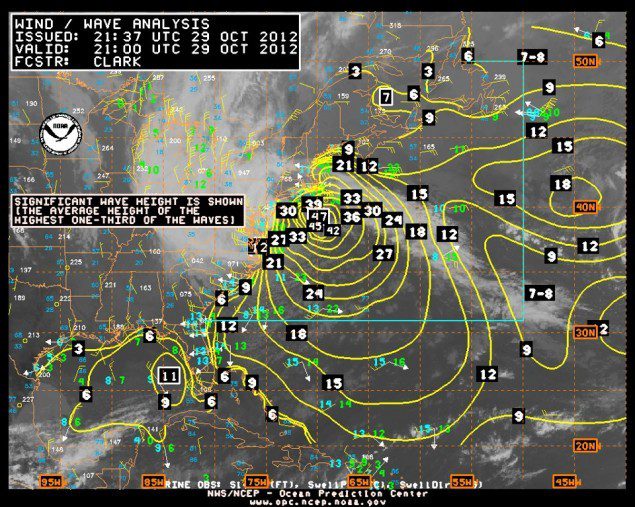Trump Tariffs on Russia’s Oil Buyers Bring Economic, Political Risks
From punishing Brazil to trying to curb imports of fentanyl, U.S. President Donald Trump has wielded the threat of tariffs as an all-purpose foreign policy weapon.
“Sandy”, left, approaching landfall Monday afternoon 29 October. “Perfect Storm” right, at 12 UTC October 30 1991
With the center of Hurricane Sandy approaching the East Coast, many are reminded of the October 1991 storm that would eventually become known as “The Perfect Storm” and immortalized in the best selling book and movie of the same name.
For days, forecasters have been comparing the two storms, but now it seems like “Sandy” is telling a story all its own. Here’s a comparison of wave conditions collected offshore Delaware today.

The data here is from NOAA’s buoy 44009 located approximately 26 NM Southeast of Cape May, NJ and provided by the University of Delaware.
Granted, the path of the “1991 Perfect Storm” and “Sandy” are slightly different and therefore a comparison of a single buoy off the coast of Delaware is not exactly comparing apple to apples, but check out these numbers below.
1991 “Perfect Storm” Wave Heights
On October 30, 1991, a buoy located 425 km (264 mi) south-southeast of Halifax reported a peak wave height of 30.5 m, or 100 ft., representing the highest wave height ever measured on the Scotian Shelf. Further south, a buoy located East of Cape Cod reported maximum sustained winds of 56 mph with gusts to 75 mph, and a significant wave height (meaning the average height of the highest waves) of 39 feet, or 12 meters, on October 30, 1991.
Sandy Wave Heights
Oct 29, 2012 21Z wind/wave analysis has indicated 47 ft sea heights (again meaning the average height of the highest waves) associated with Hurricane Sandy. The storm is now even being declared the Atlantic’s Ocean’s biggest-ever tropical storm.

Latest Sandy update from OceanWeatherServices Blog:
As of 2PM EDT Sandy was near 38.3N/73.1W and was accelerating towards the northwest at 24 knots (27mph) with max winds of 80 knots (90mph) and a minimum pressure of 940MB. Sandy deepened earlier today as it moved across the northern limit of the Gulf Stream and since has started to accelerate towards the northwest and will likely make landfall near Atlantic City, NJ late this afternoon or early this evening.
Hurricane force winds extend out about 160NM to the southwest while gale force winds extend out up to 420NM from the center. Gale force winds were already occurring from southern New England across Long Island Sound and Long Island southward along the coasts of NJ, Delaware, eastern Virginia including the Delaware and Chesapeake Bays. Hurricane force winds could reach portions of the Middle Atlantic states including New York City and Long Island by late this afternoon. NOAA OPC wave analysis indicted waves associated with Sandy of up to 43 feet.
Here’s a photo of a wave seen today in Cape May, NJ.


Sign up for gCaptain’s newsletter and never miss an update

Subscribe to gCaptain Daily and stay informed with the latest global maritime and offshore news
Essential news coupled with the finest maritime content sourced from across the globe.
Sign Up